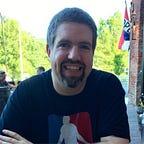John Carpenter Created the Entire ‘Halloween’ Score in Two Weeks
Once the editing for Halloween was complete, director John Carpenter went looking for feedback on his 1978 classic before releasing it to the general public. To get a sense of how the movie would play with audiences, he showed it to a Hollywood insider. “I screened the final cut, minus sound effects and music, for a young executive from 20th Century-Fox,” he explained on his website. “She wasn’t scared at all. I then became determined to ‘save it with the music.’”
The inspiration for Carpenter’s spine-tingling compositions that would “save” Halloween came from other influential film composers like Bernard Herrmann, the man responsible for the scoring Psycho. Carpenter also credits composer Ennio Morricone, who he later collaborated with on The Thing, as another major influence.
Though he was was far from a seasoned veteran when he crafted the Halloween soundtrack, Carpenter did have experience scoring his first two films, Assault on Precinct 13 and Dark Star. Experience aside, he is very honest about why he chose to handle composing duties himself. “I was the fastest and cheapest I could get,” he said.
“His fine taste and musicianship polished up the edges of an already minimalistic, rhythm-inspired score.”- John Carpenter on Working With Co-Producer Dan Wyman
The score for Halloween was recorded at Sound Arts Studios in central Los Angeles. According to Carpenter, at the time the studio was “a small brick building in an alley.” Carpenter, who is often very modest about his musical abilities, also had the assistance of co-producer Dan Wyman to help turn his vision into a coherent final product. In addition to their work together on Halloween, the two had also collaborated a few years prion on Assault.
Wyman handled a variety of tasks during his work with Carpenter. “He programmed the synthesizers, oversaw the recording of my frequently imperfect performances, and often joined me to perform a difficult line or speed-up the seemingly never ending process of overdubbing one instrument at a time,” Carpenter said. “His fine taste and musicianship polished up the edges of an already minimalistic, rhythm-inspired score.”
Carpenter and Wyman worked in what Carpenter refers to as the “double-blind mode.” Due to lack of available technology, budget, and time, the two composers were forced to work “in the studio, on the spot, without reference or synchronization to the actual picture.” An ability to overcome the less-than-ideal constraints Carpenter and Wyman faced speaks to their intuitive sense of how to make sound work with image, as the Halloween score serves as a perfect compliment for the visuals.
According to Carpenter, the first track they recorded was the legendary theme song. A sinister masterpiece that instills a feeling of dread inside of the listener, the idea for the song’s pacing came from something Carpenter’s father had shown him almost 20 years prior. “The rhythm was inspired by an exercise my father taught me on the bongos in 1961, the beating out of 5–4 time,” he said.
“Someone once told me that music, or the lack of it, can make you see better. I believe it.”
Much has been made about the limited funds and time that Carpenter had to work with while making his film. And just as the writing, directing, and editing of Halloween were limited by budget and time, so too was the score. “The scoring sessions took two weeks because that’s all the budget would allow,” Carpenter said of the tight timeline. Though the two young composers were forced to work at breakneck speed, Carpenter seemed happy with the final outcome. “My plan to “save it with the music” seemed to work,” he said later when reflecting on the outcome of the film.
In recent years Carpenter has moved away from directing to focus on his musical talents. Recording with his son, Carpenter has released two volumes of his acclaimed Lost Themes series. This transition makes sense, as Carpenter seems to be just as passionate about music as he is about film.
“The movie takes on it’s final style, and it is on this that the emotional total should be judged,” Carpenter said about the process of seeing a film once music and sound effects have been added. “Someone once told me that music, or the lack of it, can make you see better. I believe it.”
Connect with John Carpenter on Bandcamp, Facebook, his website, and on Twitter @TheHorrorMaster.
Want more engaging narrative non-fiction music journalism and curated playlists? Sign up for the Micro-Chop Substack newsletter.
If you enjoyed this piece, please consider following my Micro-Chop publication.
